Figures & data
Fig. 1 Spatial distribution of: (a) monthly Climate Data Record (CDR) concentrations, (b) local standard deviation (SD), (c) monthly NASA Team (NT) concentrations and, (d) concentration difference between monthly Bootstrap (BT) and NT estimates for the Northern Hemisphere in September 2000. The units are percent concentration.
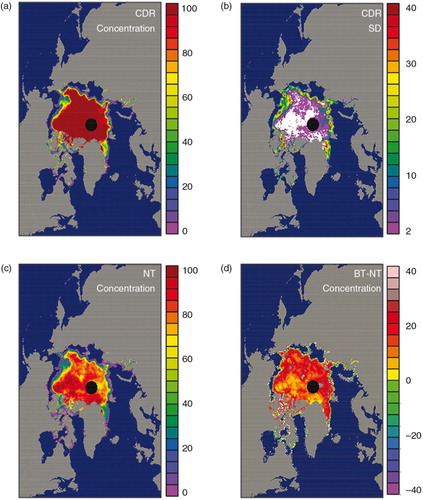
Fig. 2 Spatial distribution of: (a) monthly Climate Data Record (CDR) concentrations, (b) local standard deviation (SD), (c) monthly NASA Team (NT) concentrations and, (d) concentration difference between monthly Bootstrap (BT) and NT for the Southern Hemisphere in September 2000. The units are percent concentration.
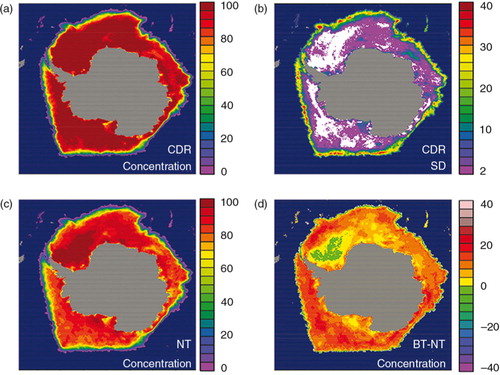
Table 1 Summary of the characteristics of the National Oceanic and Atmospheric Administration Climate Data Record (CDR) concentration and the comparison combined Goddard Space Flight Center (GSFC) concentration. Main differences between the two are shown in boldface.
Fig. 3 Number of missing grid cells over the full grid (136 192 grid cells total) for each day, 2 January 1988–31 December 2007 in (a) the Northern Hemisphere and (b) the Southern Hemisphere. The y axis is logarithmic. Values >100 000 represent days with no data (i.e., all grid cells are missing).

Table 2 Number of days over 1 January 1988–31 December 2007 in each hemisphere with missing grid cells in each range. There were no days with >40 000 missing grid cells other than days with no data.
Fig. 4 Spatial distribution of 20 years (1988–2007) (a) mean and (b) standard deviation (SD) of monthly sea-ice concentrations from the National Oceanic and Atmospheric Administration Climate Data Record (CDR), Goddard Space Flight Center (GSFC), Bootstrap (BT) and NASA Team (NT) algorithms in the Northern Hemisphere. Units are fraction ice concentration (0–1). Grid cells with sea-ice concentrations less than 0.15 (15%) are not included in the calculations.
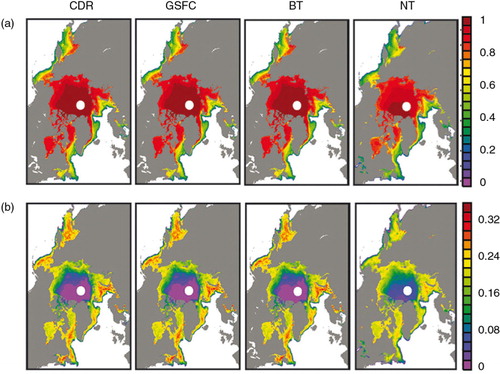
Fig. 5 Spatial distribution of 20 years (1988–2007) (a) mean and (b) standard deviation (SD) of monthly sea-ice concentration from the National Oceanic and Atmospheric Administration Climate Data Record (CDR), Goddard Space Flight Center (GSFC), Bootstrap (BT) and NASA Team (NT) algorithms in the Southern Hemisphere. Units are fraction ice concentration (0–1). Grid cells with sea ice concentrations less than 0.15 (15%) are not included in the calculations.
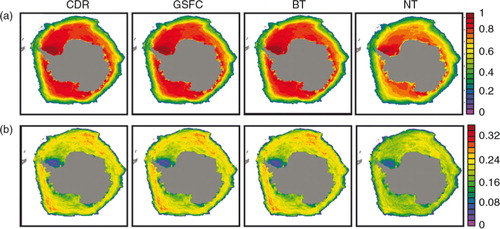
Fig. 6 Spatial distribution of bias (mean difference) and root mean square difference (RMSD) of monthly sea ice concentration anomaly between: (a), (e) the National Oceanic and Atmospheric Administration Climate Data Record (CDR) and Goddard Space Flight Center (GSFC); (b), (f) CDR and Bootstrap (BT); (c), (g) CDR and NASA Team (NT); and (d) and (h) BT and NT in the Northern Hemisphere. Note that the scale factor for (c), (d), (g) and (h) is five times larger than that of (a), (b), (e) and (f). Units are in fraction concentration (0–1). Grid cells with sea-ice concentrations less than 0.15 (15%) are not included in the calculations.
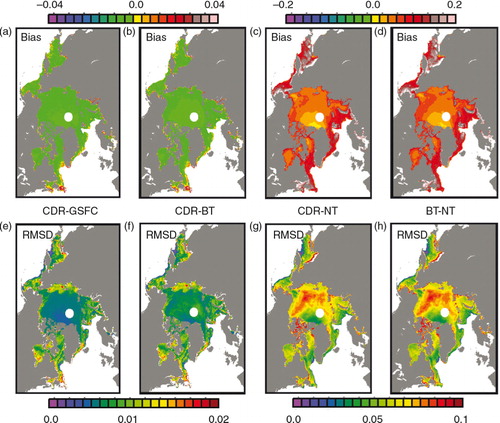
Fig. 7 Spatial distribution of bias (mean difference) and root mean square difference (RMSD) of monthly sea ice concentration anomaly between: (a), (e) the National Oceanic and Atmospheric Administration Climate Data Record (CDR) and Goddard Space Flight Center (GSFC); (b), (f) CDR and Bootstrap (BT); (c), (g) CDR and NASA Team (NT); and (d) and (h) BT and NT in the Southern Hemisphere. Note that the scale factor for (c), (d), (g) and (h) is five times larger than that of (a), (b), (e) and (f). Units are in fraction concentration (0–1). Grid cells with sea-ice concentrations less than 0.15 (15%) are not included in the calculations.
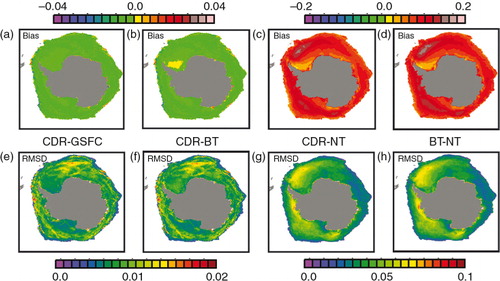
Fig. 8 Time series of monthly Northern Hemisphere the National Oceanic and Atmospheric Administration Climate Data Record (CDR) (a) extent and (b) area for 1988–2007 (thick solid lines: blue for March and red for September) and difference between CDR and Goddard Space Flight Center estimates (dashed lines). Note the different y axis scales for the extent/area (left axis) and the differences (right axis). The dotted lines are linear trends.
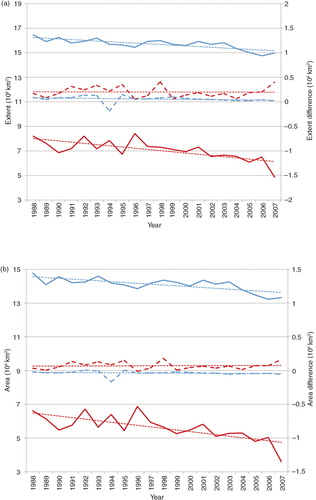
Fig. 9 Times series of monthly Southern Hemisphere National Oceanic and Atmospheric Administration Climate Data Record (CDR) (a) extent and (b) area for 1988–2007 (thick solid lines: blue for March and red for September) and difference between CDR and Goddard Space Flight Center estimates (dashed lines). Note the different y axis scales for the extent/area (left axis) and the differences (right axis). The dotted lines are linear trends.
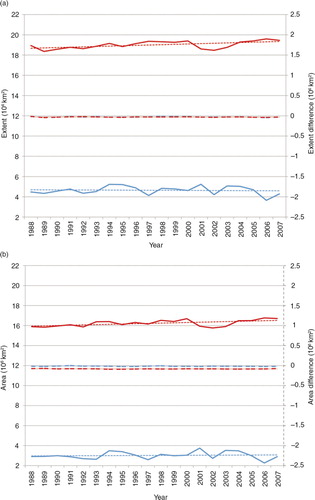
Fig. 10 The scatter diagram of monthly sea ice extents (106 km2) from monthly National Oceanic and Atmospheric Administration Climate Data Record (CDR) and (a) Goddard Space Flight Center, (b) NASA Team (NT) and (c) Bootstrap (BT) data. The left column of diagrams is for the Northern and the right is for the Southern Hemisphere.

Table 3 Confusion matrix for comparison of National Oceanic and Atmospheric Administration Climate Data Record (CDR) and Goddard Space Flight Center (GSFC) sea-ice extent. a and d represent correct “forecasts” counts for a given time period, while b and c are incorrect, using GSFC as the “correct” estimate.
Table 4 A summary of results of confusion matrix for September and March for the Northern (NH) and Southern (SH) hemispheres for the 20-year period from 1988 to 2007. The mean, minimum and maximum percentages for each month are provided as well as the overall range of percentages.
Fig. 11 Confusion matrix diagrams for the (a) and (b) Northern Hemisphere and (c) and (d) Southern Hemisphere in (a) and (c) March and (b) and (d) September. GSFC refers to the sea ice fields produced by Goddard; CDR are the climate data record fields. Note that different scales are used in the shaded areas. The circled “x” marks the value of the percentage occurrence of year 1988 for the event, with adjacent empty circles moving clockwise representing subsequent years through 2007.
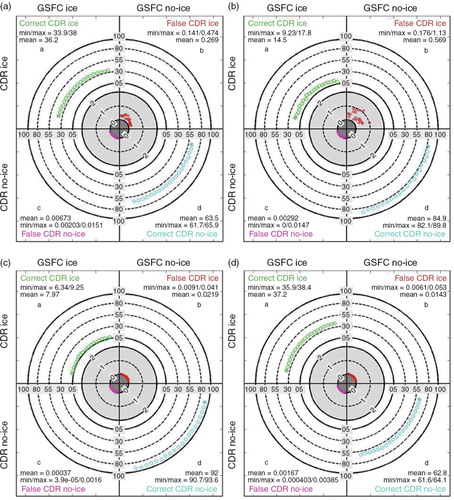
Fig. 12 Temporal evolution of (a) and (b) accuracy, (c) and (d) precision, (e) and (f) false/incorrect classification of the National Oceanic and Atmospheric Administration Climate Data Record (CDR parameter in (a), (c) and (e) March and (b), (d) and (f) September for the Northern Hemisphere for the period of years 1988–2007. A 15% concentration cut-off is used to delineate ice and no-ice classification and missing grid cells are not included. The mean, minimum and maximum monthly values over the entire 1988–2007 period are given at the top of each plot.
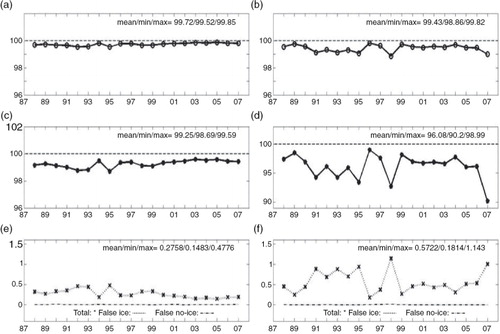
Fig. 13 Temporal evolution of (a) and (b) accuracy, (c) and (d) precision, (e) and (f) false/incorrect classification of the National Oceanic and Atmospheric Administration Climate Data Record (CDR) parameter in (a), (c) and (e) March and (b), (d) and (f) September for the Southern Hemisphere for the period of years 1988–2007. A 15% concentration cut-off is used to delineate ice and no-ice classification and missing grid cells are not included. The mean, minimum and maximum monthly values over the entire 1988–2007 period are given at the top of each plot.

Table 5 Monthly sea-ice extent trend estimates (in km2) over 1988–2007 for the National Oceanic and Atmospheric Administration Climate Data Record (CDR) and the difference between CDR and Goddard Space Flight Center (GSFC) for the Northern and Southern Hemispheres.
Fig. 14 Northern Hemisphere CDR ice area for (a) March and (b) September from the National Oceanic and Atmospheric Administration Climate Data Record (CDR; red), Bootstrap (blue) and NASA Team (green), in solid lines. Dashed lines are the difference between CDR and Goddard Space Flight Center. Dotted lines are linear trends.
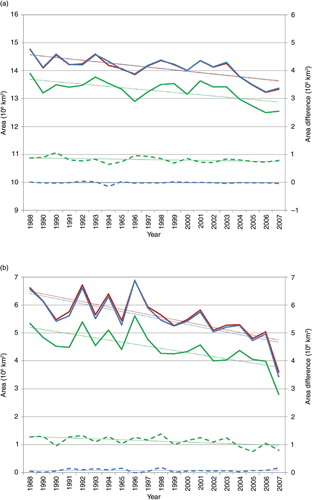
Fig. 15 Southern Hemisphere CDR ice area for (a) March and (b) September from the National Oceanic and Atmospheric Administration Climate Data Record (CDR; red), Bootstrap (blue) and NASA Team (green), in solid lines. Dashed lines are the difference between CDR and Goddard Space Flight Center. Dotted lines are linear trends.
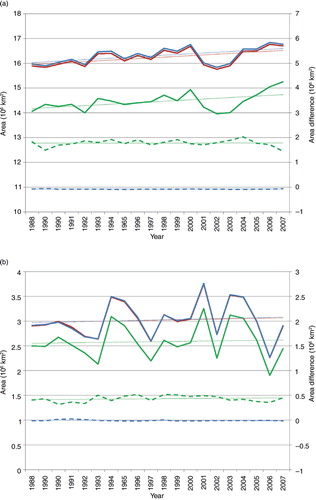
Table 6 Monthly sea-ice extent trend estimates (in km2) over 1988–2007 for the National Oceanic and Atmospheric Administration Climate Data Record (CDR) and the difference between CDR and NASA Team (NT) for the Northern and Southern Hemispheres.
Table 7 Monthly sea ice extent trend estimates (in km2) over 1988–2007 for the National Oceanic and Atmospheric Administration Climate Data Record (CDR) and the difference between CDR and Bootstrap (BT) for the Northern and Southern Hemispheres.
